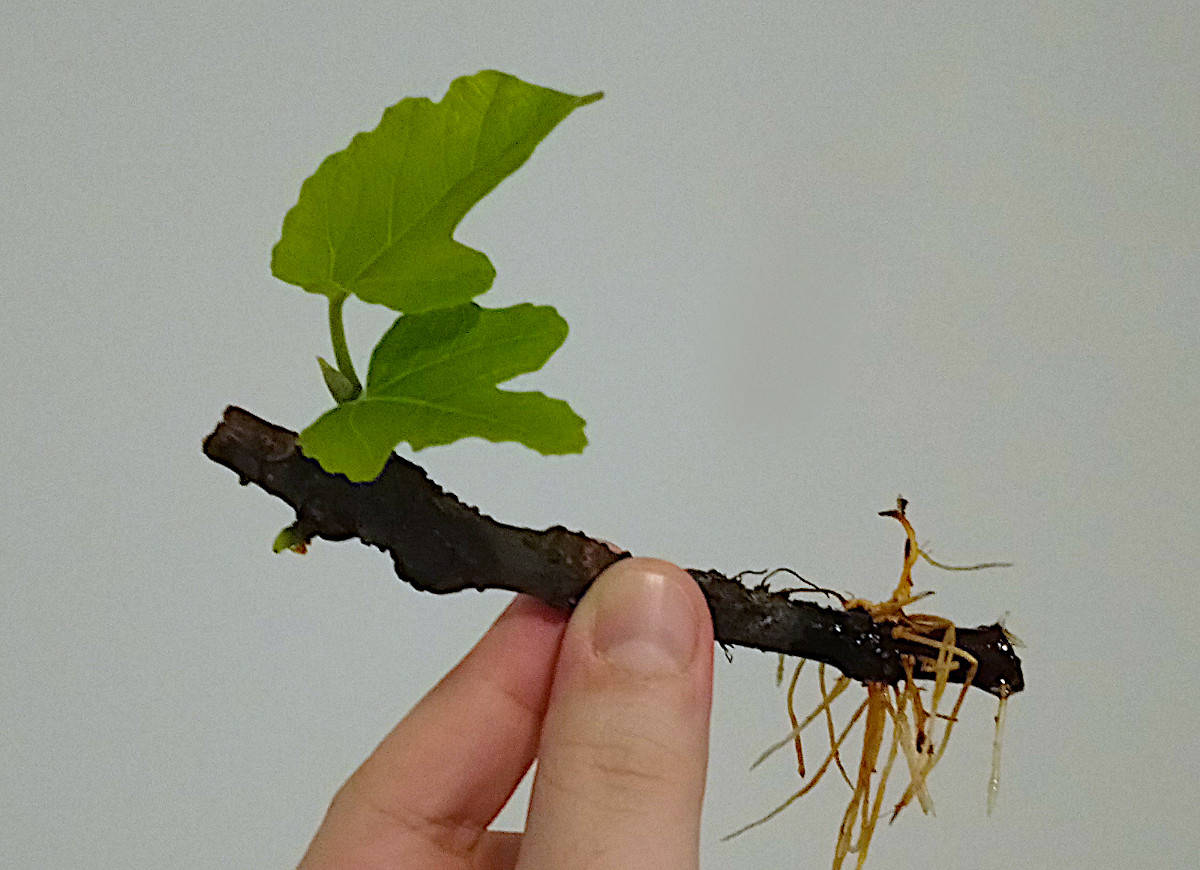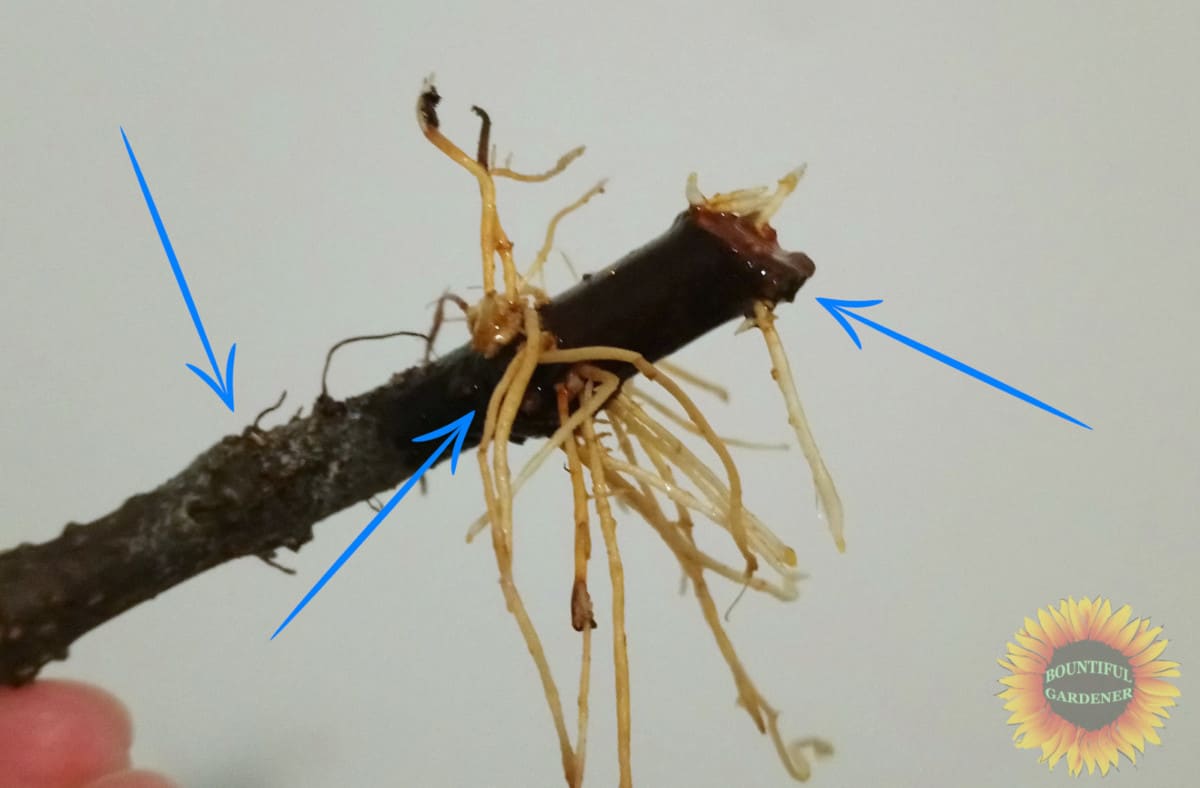Figs are a staple in many gardens and for good reason. They can thrive in a variety of growing conditions, and they’re more forgiving than other fruit trees. If you have a fig tree you want to propagate, whether it’s to expand your garden, share with others, or just to use those branches after winter pruning, it’s easy to do via cuttings.
Many vegetables and herbs can be propagated by cuttings in water, including vegetables like tomatoes and peppers, and herbs like mint and thyme. Many trees can also be propagated with cuttings, and fig trees are among the easiest to root in water.
Below are tips on how to go about propagating fig trees, whether they are ornamental or fruit-bearing trees.
On this page:
Can You Root Fig Tree Cuttings in Water?

Fig cuttings can be easily rooted in water. You don’t need any special tools, only sanitized heavy-duty scissors or pruners, a cup, and some water. The whole process can take as little as three weeks, but may take more than a month.
Benefits of Rooting Fig Cuttings in Water vs. Soil
The conventional way of rooting tree cuttings, including fig trees, is in soil. However, while soil allows roots to naturally grow and spread, and there is less risk of your figs getting waterlogged roots, rooting in water has several other advantages which outweigh the cons.
- Rooting cuttings in water prevents your cuttings from drying out before rooting.
- If using clean water that’s changed every few days, there is a lower risk of your fig cuttings rotting before they can root.
- You can see what’s happening to your cuttings in real time, being able to see which ones have successfully rooted, as well as identify which ones are rotting and should be discarded.
- Root rot is not an issue if you transplant into soil after a few healthy, strong roots have formed. Fig roots also seem to be more tolerant of growing in water for an extended period of time before transplanting.
- Fig cuttings root very easily in water and have a high success rate, unlike some other fruit trees (i.e. citrus trees).
The third benefit is especially important, since there’s no guessing game as to whether your cuttings have rooted or not. Cuttings will often start growing leaves before they’ve rooted, so the only way to know for sure if propagating in soil is to see the roots growing out the bottom of a pot or digging around your cuttings to check on root growth.
How Long Does It Take to Root Fig Cuttings in Water?
Assuming your fig cuttings don’t start rotting before they root, expect to see the first roots within 3 to 4 weeks. If it’s past 4 weeks and your fig cuttings look healthy, are putting out new growth, yet still haven’t rooted, be patient and give them more time.
Should You Root Fig Cuttings in Summer or Winter?
The best time to take and root fig cuttings is when you prune your fig tree, which is ideally in winter when the tree is dormant.
That said, you can take fig cuttings in summer, and the pictured rooted cutting in this article was originally cut in late September before starting to root in late October. If taking cuttings in the summer, remove any figlets (baby unripe figs) and leaves, except for any small ones just beginning to grow. Also check for and remove any pests (it helps to give cuttings a quick wash and rinse in cool or lukewarm water).

How to Take a Cutting from a Fig Tree
Taking cuttings from your fig tree is very easy. Below are tips on how to get through the process if you’ve never pruned a fig tree before:
- Sanitize your pruners or heavy-duty scissors with alcohol or soak in a 1:9 bleach-to-water solution for 30 minutes. You can also wash them with warm, soapy water, but sanitizing will greatly reduce your chance of spreading disease to your cuttings or your mother tree.
- Select a branch with at least two nodes, and preferably three or more. You can also cut off a longer branch and divide it into smaller cuttings of at least 4-7 inches, each with three or more nodes. A node is a “knot” in a branch where new shoots or roots will grow. Make sure there are one or two nodes lower on the branch (for root growth), and at least one near the top (for leaf growth).
- Important Note: Always remember the direction of your cutting so it’s not pointing upside down while rooting. One tip is to cut the bottom at an angle and keep the top flat, that way you know which part to submerge in water.
- It’s recommended to take cuttings when your tree is dormant in winter, but if taking cuttings during the growing season, remove any baby figs (figlets) and leaves. New leaf growth will occur at the nodes.
- Wash and rinse your cuttings in cool or lukewarm soapy water. This optional step will help remove any pests on the branch. Some fig growers also give the branches a quick 10- to 30-second dip in 1:9 bleach-to-water solution to also kill off any fungal spores on the surface. If you have a problem with fig cuttings rotting before they root, you can try a brief bleach solution soak.
Pro-Tip: Take several cuttings to help guarantee success. You can also keep multiple cuttings in the same cup while they root.
How Much Water Is Needed to Root a Fig Cutting?
You only need enough water to cover at least one node on a fig cutting. However, keeping two nodes submerged in water and at least one node above the water will ensure you always have at least one node constantly wet.
Change the water every few days to reduce the chance of your cuttings rotting.
Light Requirements for Propagating Fig Trees
Indirect light, such as next to a window or on the kitchen counter, is more than sufficient for rooting fig cuttings. Fig trees are shade tolerant, and although they grow best and fruit more in full sun, cuttings require very little light to survive.
After you’ve rooted and transplanted your fig cuttings, you can place them in partial sun or ideally full sun. Fig trees also thrive under grow lights.
When and How Should You Transplant Rooted Fig Tree Cuttings?
As long as a fig cutting has several healthy, long roots, it’s safe to transplant. Avoid transplanting when there are only one or two roots, or if the roots are still very small.
The safest way to transplant a cutting while minimizing damage to roots is to backfill around the roots with soil or potting mix. Start by filling up the bottom of your pot, then place your cutting in the pot, holding it up with one hand while pouring soil or potting mix around it until you’ve completely covered the roots.
After transplanting, water thoroughly to reduce transplant shock.
How Long Does It Take for a Fig Cutting to Fruit?
If growing fig trees for production, expect a good crop within 3 to 5 years from rooting your cutting. However, you don’t have to wait that long to get any figs. Fig cuttings can produce figs within 2 years. It just takes a few years more to grow large enough to produce a more substantial harvest.
Conclusion
Fig trees are very easy to propagate in water. As long as you use clean pruners, take multiple cuttings, and ensure at least one node is submerged in fresh water (and that the cuttings are not upside down!) you’ll be multiplying your fig harvests within a few short years. And propagated figs make great gifts for friends and family.
